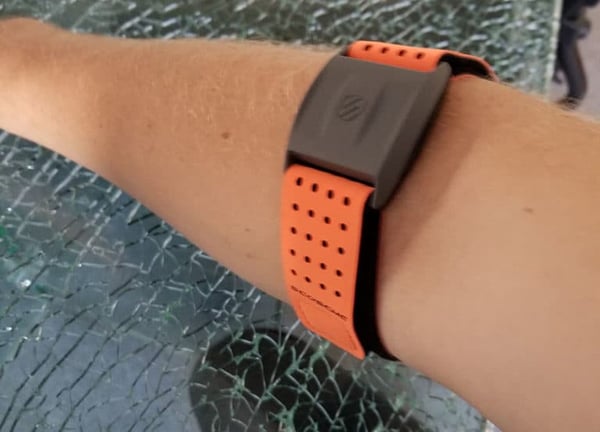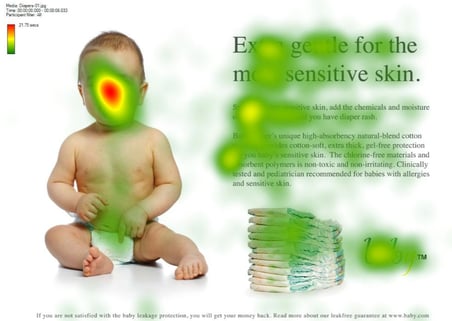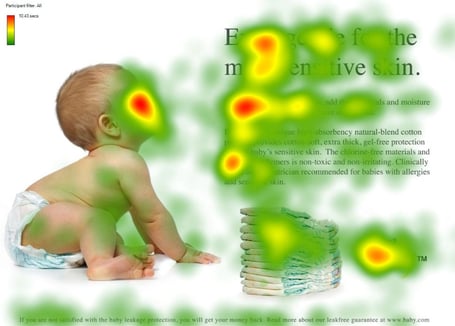If digital and traditional marketers faced off in a debate about whose promotional philosophy is superior (which would probably get more heated than an NSYNC versus Backstreet Boys dispute), one of the points digital marketers could hang over traditional marketers' heads is their ability to measure a campaign's performance -- and their opponent's inability to do the same.
Whether its views, social shares, scroll depth, subscriptions, leads, and sometimes even ROI, digital marketers can measure it all. But even though we have access to a laundry list of metrics, we still can't measure what is arguably the most crucial indicator of a campaign's performance -- emotional resonance.
Don't get me wrong, I love seeing a spike in traffic as much as the next blogger. But in an industry where skimming a page for 10 seconds counts as a view, leaving your desk to grab some string cheese will result in a time-on-page of five minutes, and 50% of web traffic and engagement are generated by bots and Chinese click farms, claiming digital metrics are a surefire way to gauge your content's emotional impact is a stretch.
But what if we could actually measure emotional resonance? What if we could place a resonance score next to a piece of content, just like we do with views?
Interestingly enough, there are companies spearheading this movement and developing technology that can gauge people's emotional response to your content without needing to draw blood or scan any brains.
In 2017, Immersion Neuroscience developed the INBand, an armband that can measure your brain's oxytocin levels by tracking the cadence of your Vagus -- a nerve that controls your heartbeat.

Oxytocin is known as the empathy chemical. When it's coursing through your brain, you relate to others more, care about them, and feel an urge to help them. And when your brain synthesizes the chemical while consuming marketing materials, it's one of the best indicators of emotional engagement and, in turn, quality content.
In 2018, Immersion Neuroscience wanted to compare people's oxytocin levels while they watched Superbowl ads to their self-reported preference of the same ads. So they hooked eight people up to the INBand and measured their neurochemical responses to 17 ads from the 2018 Superbowl. Then, they compared each ad's immersion scores to their ranking on USA Today's Ad Meter, which is ranked by the public.
What they found was quite shocking -- their results were almost the complete opposite of USA Today's Ad Meter rankings. In fact, the ad that generated the most emotional engagement in the study was ranked the least popular ad in USA Today's Ad Meter.
Immersion Neuroscience's findings suggest that knowing what the brain actually resonates with is much more important than knowing what people say they like, especially when you test ideas in focus groups -- participants are prone to shielding their true opinions due to groupthink and the urge to please authority figures.
So to accurately gauge our content's emotional resonance, and in turn, its ability to grab people's attention, make them feel something, and compel them to act, we need to focus more on neuroscience and less on web metrics and in-person interviews.
Neuromarketing Research
Neuromarketing research commonly uses either brain-scanning technology or physiological measurements to assess consumers' subconscious preferences and can help inform advertising, product development, or marketing materials.
This is typically done through brain scanning — either with fMRI or EEG technology — or physiological tracking, including eye movement measurements, facial coding, or measurements related to body temperature and heart rate.
fMRI and EEG technology have different strengths. For instance, Dr. Roeland Dietvorst, Scientific Director at Alpha, told the Neuromarketing Science and Business Association, "Normally we use EEG for the measurement of dynamic stimuli, like video, TV shows, commercials, online user experience. In such cases, it is interesting to see the brain responding moment-to-moment. We use fMRI mainly for static stimuli, like packaging design, campaign slogans, pay-offs, outdoor messaging."
Measuring physiological tracking is typically much easier to do. There are tools available to the marketplace including FaceReader by Noldus, which measures facial expressions, or various eye tracking software.
However, even though leveraging neuroscience to inform your marketing strategy is an ideal and exciting opportunity, the tactic still seems more suited for a time where Black Mirror storylines are a reality.
In fact, one of the main questions people have is, "Is neuromarketing even ethical?"
Below, let's dive into that question.
Neuromarketing Ethics
While the purpose of neuromarketing is to determine how consumers respond to brands or campaigns, a rather innocuous study, not everyone is convinced that it's ethical.
The study, "Is Neuromarketing Ethical? Consumers Say Yes. Consumers Say No," addresses ethical questions such as, "Will brands be able to influence buyer decisions too much?" and "Is neuromarketing manipulative?"
In and of itself, neuromarketing isn't unethical. However, it's important that companies hold themselves to a high standard of ethics when studying their consumers.
For instance, brands shouldn't intentionally promote anything that's harmful, deceptive, or illegal. Additionally, you shouldn't study minors to figure out how to hook them on a product.
Neuromarketing should be used to create effective ads and eliminate ads that just don't work, and that's all.
The main ethical questioning has more to do with your product or service, and less to do with how you market it. If you're ever in doubt, ask yourself if the product or service is good for the customer.
In actuality, neuromarketing has already permeated into the content space. Netflix, Hulu, and some television networks use neurotrackers to predict how successful their shows will be -- at an 84% rate of accuracy -- and this methodology could soon seep into the marketing industry.
To help you envision a world where neuromarketing is widespread, here are five practical ways brands can nail their marketing with the help of neuroscience.
1. Brands can tell more compelling stories.
When Shane Snow, an author, journalist, and co-founder of Contently, first tried out the INBand to see what the neuromarketing fuss was all about, the CEO of Immersion Neuroscience, Dr. Paul Zak, played this advertisement for him:
After Shane finished watching the ad, he started tearing up. But as he wiped away his tears before Dr. Zak could see them, he realized it was a lost cause -- the INBand had already revealed that the ad made him cry.
.jpg)
At each point of the ad where the father gets rejected, the corresponding points on the graph show that Shane experienced bursts of emotion because he developed empathy for him. And at the end of the ad, you'll notice a corresponding spike in emotion on the graph that shows exactly where he cried. The ad's emotional effects even bled over to Shane's reality, making him feel empathetic toward the father after the ad ended, which is evidenced by the last spike's gradual fade.
Shane's emotional response to this ad suggests that telling great stories, chock-full of conflict, surprise, and emotion, is one of the best ways to trigger the release of oxytocin, helping you emotionally engage your audience and, ultimately, make them care about your brand.
In a nutshell, great stories are about the journey of overcoming adversity and how that journey changes people. “Little Moments,” tells the story of a father who so desperately wants to connect with his teenage daughter but ultimately can't make it happen. And at the end of the ad, her constant rejection clearly weighs on him, prompting him to lay down on her bed. But that's when he sees all the photos they've taken together over the years taped above her bed, making him realize that she's always had a connection with him -- he just didn't know it.
2. Businesses can save millions of dollars on ads.
In the same study of 2018 Superbowl ads mentioned above, Immersion Neuroscience discovered that M&Ms' “Human” was the second most immersive ad on their list.
As you can probably predict, “Human” generated the most emotional engagement when the truck plows Danny DeVito into the basket of produce. But a few seconds after this shocking and hilarious climax, Immersion Neuroscience discovered that emotional engagement plummeted, suggesting M&Ms could've shaved off the last 10 seconds of this ad -- and saved over $1.5 million.
3. Companies can host more engaging conferences.
At a major global conference in Houston last year, Immersion Neuroscience put INBands on attendees and measured their immersion during certain presentations. They discovered that concise, energetic talks generated the most emotional engagement.
On the other hand, longer talks need to revolve around a strong narrative or else they can't hold an audience's attention. Additionally, they realized the brain responds well to multimedia-heavy presentations due to the high variety of stimulus.
Based on these findings, Immersion Neuroscience believes tracking attendees' emotional engagement during presentations can help companies refine their conferences by cutting out boring talks and even providing attendees with relevant presentation recommendations.
4. Brands can design more effective ads.
The main goal of neuromarketing is to gain insight into what would make an ad more effective. That's exactly what Roger Dooley did in a study using an ad for baby products.
To figure out if an ad was effective, Dooley used a heat map to see where viewers were looking. Are they reading the text? Just looking at pictures?
In the ad below, the baby is looking straight out of the page. Unsurprisingly, viewers love the image of the baby. Most people give the image of the baby more attention than the headline and copy.

However, when you have the baby "look" at the headline and copy, viewers started to give the copy more attention. That's because people will look at the same thing the models are looking at. So, with the image above, where the baby was looking right at us, you weren't directed to look at anything else, so you probably stopped looking around.
Ultimately, this neuromarketing study helped create a more effective ad. In your future ads, try to make sure your models are looking at what you want the viewer to see.
5. Brands can sell more by using FOMO.
The fear of missing out, otherwise known as loss aversion, is a widely used tactic in marketing and sales.
In fact, in a study, 62% of consumers were more likely to gamble their money than to lose their money.
Here's the scenario consumers were given:
If you were given $50, would you rather:
- Keep $30.
- Gamble, with a 50/50 chance of keeping or losing the whole $50.
When an experimenter posed that question to subjects, 43% of the subjects chose to gamble. Then the options were changed to:
- Lose $20.
- Gamble, with a 50/50 chance of keeping or losing the whole $50.
With that slight change, there was a 44% jump in the number of people who gambled.
In fact, when more studies were done like this, 100% of subjects gambled more when the other choice was framed as a loss.
The neuromarketing takeaway is that framing will have a large impact on peoples behavior. And people are loss averse.
You can implement this method by changing the language on your ads. If you can pose the outcome of not buying your product or service as a loss, then you can sell more.
6. Brands can ensure their packaging is effective.
Brands might consider using neuromarketing to measure viewers' emotional reactions to different packaging designs and determine which packaging option evokes the highest level of position emotion and engagement.
As we'll discuss more in the section below, Frito-Lay did exactly that after using neuromarketing to determine which type of packaging appealed most to women. The company came to the conclusion that packaging with healthy ingredients on the front evoked a better reaction from women, and as a result, re-designed packaging to show images of dressing or spices to highlight the natural ingredients in Frito-Lay's snacks.
7. Businesses can determine the right price for a product or service.
Pricing is all about psychology.
For instance, University of Florida marketing professors Chris Janiszewski and Dan Uy wanted to evaluate whether consumers' will truly evaluate a product as more fairly priced if its $19.95 rather than an even $20. They conducted a range of experiments and found people "create mental measuring sticks that run in increments away from any opening bid, and the size of the increments depends on the opening bid."
Or, put another way: If you see a product priced $19.95 you might wish it was $19.75 or $19.50, but you'll be thinking in terms of nickels and dimes. However, if you see a product priced to the nearest full dollar — such as an even $20 — you instead might wish it was priced at $19 or $18, moving the range further away from the actual price.
Similarly, you might consider evaluating consumers' perception of price using neuromarketing. If you ask a focus group whether they believe your product is priced fairly, they might be wary to admit the truth based on groupthink. Neuromarketing, then, can be a useful measurement of consumers' subconscious reactions to certain prices.
8. Brand's can evaluate website performance.
In the Roger Dooley ad described above, Dooley used a heat map to determine the most effective version of an ad.
The same can be true for your entire website. Consider using eye movement measurement technology or other heat mapping software to track which areas of your website are most engaging to viewers, and which areas or pages are least effective.
You might consider using neuromarketing to measure reactions to website layout, color scheme, text, or even font size.
Companies that Use Neuromarketing
It's important to note — some of these brands tested out neuromarketing years ago, ranging as far back as 2009. However, neuroscience is slow to progress, so there are still helpful and relevant lessons we can learn from each of these examples.
1. Microsoft
Microsoft wanted to test the effectiveness of its campaigns on the Xbox platform — and, more specifically, how Microsoft's 30-second and 60-second TV ads performed compared to in-game ad runs on Xbox.
To conduct this research, Microsoft worked with neuromarketing companies Mediabrands and EmSense, and fitted test subjects with a headband that could track brain activity, breathing rate, head motion, heart rate, blink rate, and skin temperature. The company then showed three types of ads to test subjects – a 30-second Kia Soul TV ad, a 60-second Kia Soul TV ad, and a Kia Soul in-game ad.
The results? The TV ads caused the most brain activity in the first half of the ad. The Xbox Live ads, on the other hand, caused peak brain activity at the repeat image of the Kia Soul car, which suggests viewers will remember the ad better on Xbox.
These results were supported by more traditional metrics — for instance, the Xbox live ad delivered a 90% unaided brand recall rate, compared to 78% with the traditional TV spot.
2. Frito-Lay
Frito-Lay worked with Juniper Park, an advertising agency, in 2009 to develop a campaign that would appeal more to women. To do so, Juniper Park used neuromarketing to study women's brains, and found the hippocampus — a memory and emotional center — is larger in women, suggesting women may look more for ad characters with whom they can empathize.
Juniper Park's research also found women may have a stronger link between decision-making and feelings of guilt. Once Juniper Park explored this research with NeuroFocus, they began testing various ads to investigate how women responded.
Ultimately, the ad agency recognized women may often feel guilty, particularly when it comes to eating habits. As a result, Frito-Lay shouldn't try to get rid of this guilt — instead, the brand should highlight its healthy ingredients in its snacks, and showcase spices or dressing on the packaging to demonstrate the health quality to avoid the guilt-factor entirely.
3. The Shelter Pet Project
Nielson Consumer Neuroscience worked with the Ad Council and The Shelter Pet Project to evaluate consumers' non-conscious response to the "Meet A Shelter Pet" ad. The team used EEG and eye-tracking measurements to A/B test the impact of the Shelter's ads.
The results demonstrated that faces — including a dog's — on-screen boosted viewers' emotional engagement, and when the dog was off-screen the attention dropped. To mitigate these issues and capture higher viewership and engagement, the team shortened the dog's off-screen time and cleaned up the ending.
The Shelter Pet project saw 133% increase in website visits and a 28% increase in pet finder database searches as a result of neuromarketing.
4. German Financial Institution
In 2017, a German financial institution worked with Nielsen Consumer Neuroscience to figure out which version of their ad garnered the most trust. To do this, the team used EEG measurements to assess how emotionally engaged viewers' felt when watching two versions of an ad.
The only difference? One ad played classical music, while the other played more modern notes.
The participants were then asked to perform a task to assess how well the ad had communicated messages on a subconscious level. The results demonstrated the traditional music outperformed the more modern version, and evoked a sense of "trust" in viewers. It's likely that classical instruments are associated with a sense of stability, versus modern music which evokes a sense of excitement and risk.
Even though we live in an age of data overload, where you can measure almost anything, Google Analytics will never be able to accurately gauge the most important element of your marketing campaign -- its ability to make your audience feel something.
Fortunately, the neuromarketing space is rapidly evolving, and its technology is becoming more affordable and practical for marketers today, hopefully leading to its mainstream use tomorrow.
Editor's note: This post was originally published in January 2019 and has been updated for comprehensiveness.
How Neuromarketing Can Revolutionize the Marketing Industry [+Examples] was originally posted by Local Sign Company Irvine, Ca. https://goo.gl/4NmUQV https://goo.gl/bQ1zHR http://www.pearltrees.com/anaheimsigns


No comments:
Post a Comment